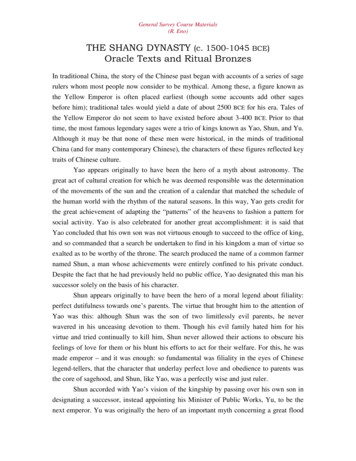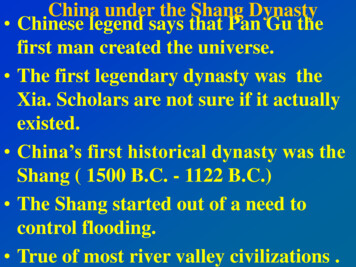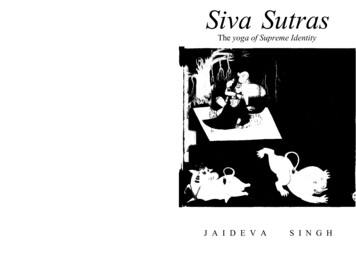
Transcription
General Survey Course Materials(R. Eno)THE SHANG DYNASTY (c. 1500-1045 BCE)Oracle Texts and Ritual BronzesIn traditional China, the story of the Chinese past began with accounts of a series of sagerulers whom most people now consider to be mythical. Among these, a figure known asthe Yellow Emperor is often placed earliest (though some accounts add other sagesbefore him); traditional tales would yield a date of about 2500 BCE for his era. Tales ofthe Yellow Emperor do not seem to have existed before about 3-400 BCE. Prior to thattime, the most famous legendary sages were a trio of kings known as Yao, Shun, and Yu.Although it may be that none of these men were historical, in the minds of traditionalChina (and for many contemporary Chinese), the characters of these figures reflected keytraits of Chinese culture.Yao appears originally to have been the hero of a myth about astronomy. Thegreat act of cultural creation for which he was deemed responsible was the determinationof the movements of the sun and the creation of a calendar that matched the schedule ofthe human world with the rhythm of the natural seasons. In this way, Yao gets credit forthe great achievement of adapting the “patterns” of the heavens to fashion a pattern forsocial activity. Yao is also celebrated for another great accomplishment: it is said thatYao concluded that his own son was not virtuous enough to succeed to the office of king,and so commanded that a search be undertaken to find in his kingdom a man of virtue soexalted as to be worthy of the throne. The search produced the name of a common farmernamed Shun, a man whose achievements were entirely confined to his private conduct.Despite the fact that he had previously held no public office, Yao designated this man hissuccessor solely on the basis of his character.Shun appears originally to have been the hero of a moral legend about filiality:perfect dutifulness towards one’s parents. The virtue that brought him to the attention ofYao was this: although Shun was the son of two limitlessly evil parents, he neverwavered in his unceasing devotion to them. Though his evil family hated him for hisvirtue and tried continually to kill him, Shun never allowed their actions to obscure hisfeelings of love for them or his blunt his efforts to act for their welfare. For this, he wasmade emperor – and it was enough: so fundamental was filiality in the eyes of Chineselegend-tellers, that the character that underlay perfect love and obedience to parents wasthe core of sagehood, and Shun, like Yao, was a perfectly wise and just ruler.Shun accorded with Yao’s vision of the kingship by passing over his own son indesignating a successor, instead appointing his Minister of Public Works, Yu, to be thenext emperor. Yu was originally the hero of an important myth concerning a great flood
2that occurred in China. The waters of all the major rivers swelled over their banks and theland was slowly sinking into sea. The legend tells us that Yu identified the problem assiltation of the river beds, and, using superhuman strength, personally dredged the riversso they would again flow within their banks. This display of dedication to the state ledShun to designate Yu as his successor. Whether for good reasons or bad, Yu is said tohave ended the tradition of non-hereditary succession to the kingship. He passed thethrone on to his son, a succession that is said to have begun the earliest dynasty. Here, webegin a transition towards historical facts.The earliest evidence we have about the origins of Chinese civilization date to theprehistoric era called the Neolithic (New Stone Age) – the term refers to the era whenagriculture begins; in China, about 7500 BCE. Because there are no written records for thelong period c. 7500 - c. 1500 BCE, our knowledge of Neolithic civilization is limited to ananalysis of the character of archaeologically revealed living sites, graves, and objects,mostly pottery. On the basis of these, it has become clear that Chinese civilizationoriginally coalesced from a variety of smaller cultural regions, very likely reflectingdifferent ethnic groups. Sometime about 2000 BCE, a dominant state-like entity seems tohave blossomed in the western part of the North China Plain. In China’s historicaltradition, the leaders of this political entity (or “polity”) were part of an hereditary rulinghouse called the Xia, which is often said to be China’s first dynasty, dated roughly 20001500 BCE. It is this dynasty which is said to have been founded by the sage king Yu.Whether the cultural remains we have recovered through archaeology truly belong tosomething as tangible as a state with a ruling dynasty – one, whose founder, perhaps, isthe basis for the legend of Yu – is still under debate. Because no writing from this era hasemerged to announce that there remains are the “Xia,” we cannot be sure. For this reason,we do not here list the Xia among China’s historical dynasties, although archaeologicalstudies may in the future establish the historicity of the Xia beyond doubt.Historical tradition tells us that about 1500, a group from the Eastern region of theYellow River Valley conquered the Xia and established China’s second dynasty, theShang, and here we enter the historical era. About a century ago, archaeologists did,indeed, unearth an elaborate settlement site north of the Yellow River’s lower reaches,occupied from about 1250-1050 BCE; they found there the earliest known written recordsof China. Inscribed on ox bones and turtle shells, which were used to speak to the worldof spirits, written in a form clearly ancestral to later Chinese characters, these documentsclearly announced that they were the records of the royal house of the Shang. Thus theShang royal house became the earliest historically confirmed dynasty in Chinese history,and it is with the Shang that we truly begin our survey of China’s cultural history.
3The state governed by the Shang Dynasty seems to have been a rather looseconfederation of tribe-like groups, who recognized the Shang royal house as possessingsome form of authority over them. TheShangc. 1700 – 1045 BCE Shang was eventually conquered by one ofZhou1045 – 256 BCEthese tribal members of its state, the ZhouQin221 – 208 BCEtribe from Western China, in about 1045Han206 BCE – 220 CEBCE. The Zhou founded China’s longest“Six Dynasties” 220 – 589lasting dynasty – it existed, at least in name,Sui589 – 617Tang618 – 907from 1045 to 256 BCE, though its true power“Five Dynasties” 907 – 960shrank drastically after 770 BCE. The ZhouSong960 – 1279is often thought of as including China’sYuan1279 – 1368“Classical” age, that is, the era during whichMing1368 – 1644China’s most enduring cultural featuresQing1644 – 1911formed. In this section, then, we are castinga brief glimpse at the culture of “proto-China,” for the Shang, though recognizablyChinese in written language, clan structure, and religious belief, really ruled China beforeChinese culture had become aware of its own identity and special nature.Our knowledge of the Shang derives principally from objects uncovered at the siteof its last capital, located near the modern city of Anyang. Palacefoundations, household neighborhoods, monumental tombs andcommon graves were all found there. Two types of objects wereof special importance: the inscribed bones and shells used forcommunicating with the world of spirits, called “oracle texts,”and spectacularly elaborate and artistic bronze ritual vessels,used in sacrificial rites and buried in tombs. In this section, wewill focus on these two types of objects to get a glimpse ofChina’s earliest civilization.The Oracle TextsThe oracle texts, which constitute almost all of the first hand written record wepossess of the Shang Dynasty, consist of primitive versions of Chinese characters etchedon large turtle shells or the shoulder blades of oxen. The characters record the questionsor statements which were proposed to the world of spirits at the time that the shells orbones were burned with hot pokers to make them crack. The cracks themselves providedthe diviner with the spirits’ response to the statements (we don’t know how to interpret
4the cracks). Occasionally, the content of the spirits’ response is recorded in theinscription of the original question, and sometimes we are even told whether the responsetallied with events as they turned out later, but this is rare.A simple, typical inscription might look like this:Transcribing character by character, first into modern Chinese and then into word forword English we get:辛亥卜 殼 貞 勿登人 三千xinhai-day crack Que divine don’t deng-sacrifice men3000Translating that into normal English we would get:“We cracked this bone on the day xinhai, Que made the divination: Should we notperform a deng-sacrifice of three thousand people?”“The day xin-hai” refers to the sixty day calendar cycle of theShang (the same system which today gives us the Year of theDragon, Horse, or whatever). “Que” was the name of aprominent diviner during the reign of the Shang ruler Wu-ding,who reigned about 1200 BCE. The final sentence records thequestion asked of the spirits. In view of its content, it is likelythat the bone was cracked soon after a major battle in whichmany members of a non-Shang tribe were captured. (Anattractive feature of Shang culture was the dutiful slaughter ofsurplus captives for the pleasure of natural and ancestralspirits.)Below are ten further inscription texts which exemplify the range of topics aboutwhich the Shang king’s diviners questioned the royal ancestors. The inscriptions concernthe Shang high god Di, sacrifices to royal ancestors, the welfare of the king and hisfamily, and matters of importance to the Shang state. In some cases, the king himself isrecorded as interpreting the answer of the spirits. (If an “X” appears, it means we don’tknow how to pronounce the Chinese character used to represent someone’s name; youcan simply “bleep” the names of the divination dates and sacrifice types.)
51. Will Di order rain sufficient for harvest?2. As for attacking the Qiong tribe, will Di provide us support?3. The King has a toothache; is Father Yi causing it?Note: Father Yi was a late uncle of the king.4. We cracked this on bing-shen day, Que divining: On the following yisi dayshall we offer wine libations to ancestor Xia-yi? The King prognosticatedsaying, “When we offer the libation there will be misfortune. There willperhaps be thunder.” On yisi day we offered wine libations. In the earlymorning it rained. Upon performing a fa-sacrifice the rain ceased. At thefa-sacrifice to Xian it also rained. We offered shi and mao-sacrifices to theBird Star.5. The King prognosticated saying, “There shall be misfortune.” On the eighthday after, gengxu, clouds in the form of a face covered the sun; a rainbowappeared and drank from the Yellow River.6. Crack making on guisi day, Que divining: These ten days there shall be nodisaster. The King prognosticated saying, “There shall be misfortune;there will perhaps come ill news thrice over.” On the fifth day thereafter,dingyou, there did indeed come ill news from the West. Guo of Zhireported saying, “The Tu tribe have attacked my eastern territories; theyhave ruined two walled towns; also, the X tribe have overrun the fields ofmy western territories.7. We cracked this on jiashen day, Que divining: Will Fu Hao have a fortunatebirth? The King prognosticated saying, “If she gives birth on a ding day itshall be fortunate; if on a geng day, it shall be greatly auspicious.” On thethirty-third day thereafter, on jiayin, Fu Hao gave birth. It was notfortunate – it was a girl.Note: Fu Hao was a chief wife of the king.8. We cracked this on xinwei day, Zheng divining: Should Fu Hao follow Guo ofZhi and attack the X tribe? Should the King attack Zhonglu from the Eastand march to where Fu Hao shall be?9. On jiawu day the King cracked this and divined: Should we perform a rongsacrifice? On the next rong-sacrifice day shall we follow Lord X tocampaign against the Ren tribe? Will the ancestors above and belowprovide support and not visit disaster upon us? Will we be able to report atthe Great City Shang that there has been no disaster? The Kingprognosticated saying, “It is greatly auspicious.”
610. We cracked this on guisi day, Que divining: These ten days shall there be no disaster?The King prognosticated saying, “There shall be misfortune.” It was as he said.On jiawu day the King went hunting a rhinoceros. The horse and chariot of PettyMinister Zai toppled over, and the King’s son Yang, who was driving the King’schariot, also fell.Shang BronzesNo other Bronze Age culture ever achieved a level of aesthetic perfection in bronzecomparable to Shang culture. The imaginative vision and technical expertise that arecombined in Shang ritual vessels represent a peak of virtuoso art that is rare in worldhistory.It should be understood that to achieve such a level of magnificence, the Shanghad to invest enormous resources. Copper and tin, the principal components of Shangbronzes, were not easy to come by. Although there are substantial deposits of theseminerals within a few hundred kilometers of site of the late Shang capital, given therudimentary forms of mining and transportation available, quarrying and shipping the oreto the capital would have been a great drain on labor and a major expense to the Shangelite.Nor were these ores invested in productive industry. The Shang could have usedcopper or bronze to strengthen their ploughs, but they did not; they could have used themto reinforce their weaponry, but with few exceptions they did not. Bronze was reservedfor the near-exclusive use of the ritual industries, and within that, chiefly for themanufacture of sacrificial vessels. It was the ancestors who enjoyed the fruits of the mostdeveloped form of manufacturing technology in Shang China.The bronzes were crafted both for use and fordisplay. The Shang people had inherite
THE SHANG DYNASTY (c. 1500-1045 . BCE) Oracle Texts and Ritual Bronzes . In traditional China, the story of the Chinese past began with accounts of a series of sage rulers whom most people now consider to be mythical.Among these, a figure known as the Yellow Emperor is often placed earliest (though some accounts add other sages











